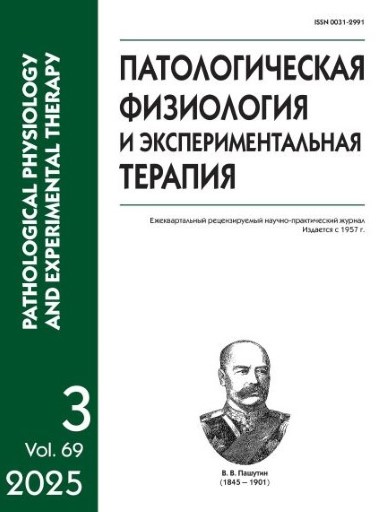Changes in the subpopulation composition of tumor-infiltrating cytotoxic Т-lymphocytes and the expression of co-inhibitory molecules on their surface in stage III colorectal cancer
Abstract
Relevance: Studying the subpopulation composition of cytotoxic T-lymphocytes and the expression of co-inhibitory proteins on their surface in the tumor microenvironment is necessary for the development of new methods of targeted therapy for colorectal cancer (CRC).
Aim: To study the subpopulation composition of cytotoxic T-lymphocytes and the expression of co-inhibitory molecules on their surface in the primary tumor growth site in patients with stage III colon cancer.
Methods. The relative content of cytotoxic T-lymphocytes in the tumor microenvironment, the subpopulation composition of cytotoxic T-lymphocytes, as well as the expression of immune checkpoints (CTLA-4, PD-1, TIM-3) by CD8-positive cells were measured in 105 patients with stage III CRC by flow cytometry. The control group consisted of 75 patients who underwent colon surgery for non-neoplastic diseases.
Results. In patients with stage III CRC, the proportion of naive cells (CD3+CD8+CD45RA+CCR7+) in the primary tumor growth site was decreased by 23.1%; the relative content of cytotoxic T-lymphocytes of central memory (CD3+CD8+CD45RA-CCR7+) and effector memory (CD3+CD8+CD45RA-ССR7-) was increased by 1.5 and 1.4 times, respectively; and the number of terminally differentiated T-cells (CD3+CD8+CD45RA+ССR7-) was decreased. In CRC patients, on the surface of CD3+CD8+ lymphocytes in the tumor microenvironment, the expression of CD57 was increased by 1.9 times, the co-inhibitory CTLA-4 molecule by 1.9 times, and the TIM-3 protein by 2.5 times.
Conclusion. In patients with stage III CRC, the subpopulation composition of tumor-infiltrating cytotoxic T lymphocytes changes, which is evident as a decreased proportion of naive and terminally differentiated T cells along with an increase in the percentage of central and effector memory cells. In stage III CRC, the expression of co-inhibitory molecules (CTLA-4 and TIM-3) on cytotoxic T lymphocytes of the tumor microenvironment increases.
Downloads
References
2. Xie Y.H., Chen Y.X., Fang J.Y. Comprehensive review of targeted therapy for colorectal cancer. Signal transduction and targeted therapy. 2020; 5(1): 1-30. DOI https://doi.org/ 10.1038/s41392-020-0116-z
3. Zheng Z., Wieder T., Mauerer B., Schäfer L., Kesselring R. et al. T Cells in Colorectal Cancer: Unravelling the Function of Different T Cell Subsets in the Tumor Microenvironment. Int. J. Mol. Sci. 2023; 24(14): 11673. https://doi.org/ 10.3390/ijms241411673
4. Kudryavtsev I.V., Borisov A.G., Vasilyeva E.V., Krobinets I.I., Savchenko A.A., Serebryakova M.K. et al. Phenotypic characteristics of cytotoxic T-lymphocytes: regulatory and effector molecules. Medical Immunology. 2018; 20 (2): 227-240. doi: 10.15789/1563-0625-2018-2-227-240
5. Chetveryakov A.V., Tsepelev V.L. Level of co-inhibitory immune checkpoints in tumor tissue in patients with colon neoplasms. Molecular Medicine. 2023; 21 (1): 56-60.
6. Chetveryakov A.V., Tsepelev V.L. Concentration of co-inhibitory immune checkpoints and their ligands in the blood of patients with colon tumor. Pathological physiology and experimental therapy. 2023; 67 (1): 56-62.
7. Kudryavtsev I.V., Borisov A.G., Krobinets I.I., Savchenko A.A., Serebryakova M.K. Determination of the main subpopulations of cytotoxic T-lymphocytes by multicolor flow cytometry. Medical Immunology. 2015; 17 (6): 525-538.
8. Mudrov V.A. Algorithms for statistical analysis of quantitative features in biomedical research using the SPSS software package. Transbaikal Medical Bulletin. 2020; 1: 140-150.
9. Kawabe T., Yi J., Sprent J. Homeostasis of naive and memory T lymphocytes. Cold Spring Harbor perspectives in biology. 2021; 13 (9): 037879.
10. Novik A.V., Kudryavtsev I.V., Nekhaeva T.L., Emelyanova N.V., Danilova A.B. Prognostic and predictive value of memory T cells in peripheral blood of patients with inoperable or metastatic melanoma. Effective Pharmacotherapy. 2021; 17 (11): 10-14.
11. Ratajczak W., Niedźwiedzka-Rystwej P., Tokarz-Deptuła B., Deptuła W. Immunological memory cells. Central European Journal of Immunology. 2018; 43(2): 194-203.
12. Kwiecień I., Rutkowska E., Sokołowski R., Bednarek J., Raniszewska, A. еt al. Effector memory T cells and CD45RO+ Regulatory T cells in metastatic vs. Non-metastatic lymph nodes in lung cancer patients. Frontiers in Immunology. 2022; 13: 864497.
13. Hossain M.A., Liu G., Dai B., Si Y., Yang Q., Wazir J. et al. Reinvigorating exhausted CD8+ cytotoxic T lymphocytes in the tumor microenvironment and current strategies in cancer immunotherapy. Medical Research Reviews. 2021; 41(1): 156-201.






